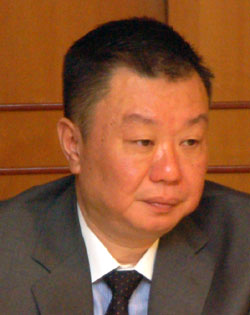 Venue: Suntec International Convention & Exhibition Centre
Venue: Suntec International Convention & Exhibition Centre
Time & date: 10 am, 22 April

AT C&G’S AGM, minority shareholders of the synthetic textile turned waste-to-energy player demanded that new shares issued pursuant to its switch in core business be excluded from FY09’s dividend distribution.
Noting the sharp 80% drop in dividend per share to 0.1 Singapore cents, more than a few minority shareholders engaged the management in a lively debate.
While dividend payout ratio had been maintained at about 17%, the dividend per share had shriveled as a result of a sharp drop in earnings available for distribution as well as dilution due to the issue of new shares.

FY09 earnings had declined by 56.5% year-on-year.
To make matters worse, 505 million new shares had been issued for C&G EPIL, its new waste-to-energy (WTE) business, more than doubling the listco's issued share capital to 973 million shares.
Minority shareholders wanted vendors of the WTE business to follow isolated precedents of cases when substantial shareholdings resulting from M&A activity were excluded from the latest financial year’s dividend distribution.
They argued that FY09 earnings were wholly from the synthetic textile business and generated from equity in issue before the acquisition was completed.
Two vendors of C&G EPIL were present at the AGM - Mr. Cai Junyi, C&G’s CEO, who sold his 17.5% stake, and its incumbent chief, Mr. Lin Yan, who sold 22.5%.
Mr. Lam Chik Tsan, C&G’s executive chairman, who sold his 60% stake in C&G EPIL, had excused himself from the AGM.
Mr Lin was present as C&G’s board member as he had been appointed executive director in conjunction with the acquisition.
The minority shareholders' demand was, however, turned down. Mr Lin explained that no dividends were paid out last year from the WTE business and its cash reserves will be consolidated to the listco from the effective date of its acquisition, i.e. 9 Feb 2010.

C&G is clear it wants a complete switch in its busines. It guided the market on 19 Apr that it is expecting a loss for its PET chips and yarn business for 1Q2010.
However, it expects to remain in the black at the consolidated level earnings contributed by its waste-to-energy business is likely to offset the segmental loss.
On 9 Feb, Rmb 563.7 million worth of new shares had been issued at 24 cents each as purchase consideration for 100% in C&G EPIL, which invests in, constructs, operates and maintains waste incineration power plants.
On 20 Mar, it entered an MOU to divest of its entire textile business for a minimum of US$49 million. The disposal is currently under the 6-week period of due diligence by the prospective purchaser.
C&G EPIL currently operates 9 WTE plants in Jinjiang, Huangshi, Hui’an, Anxi, Fuqing, Langfang, Yingkou, Nanping and Jianyang in China.
Here is a summary of questions raised by shareholders at the AGM and the management’s answers.

Q: How much will FY09’s dividend payout amount to?
We will pay about Rmb 4.719 million, or less than a million Singapore dollars.
Q: Since you have quite a high interest expense (Rmb 4.9 million in FY09), why do you still want to pay dividends?
Minority shareholders showed great displeasure when we omitted dividends in FY07. The market generally views dividends as a signal of business viability.
Q: Will the waste-to-energy business participate in the Clean Development Mechanism?
Several of our BOT projects have applied to be under this scheme. While we believe the China authorities will approve our application, we are unsure when the United Nations will actually approve our projects.
Q: Do you need to buy carbon credits for businesses emitting sulfur dioxide?
Currently, only our project at Huangshi needs to buy carbon credits. Statutory requirement on this varies from province to province.
For more on the clean development mechanism and carbon credit trading, click here.






